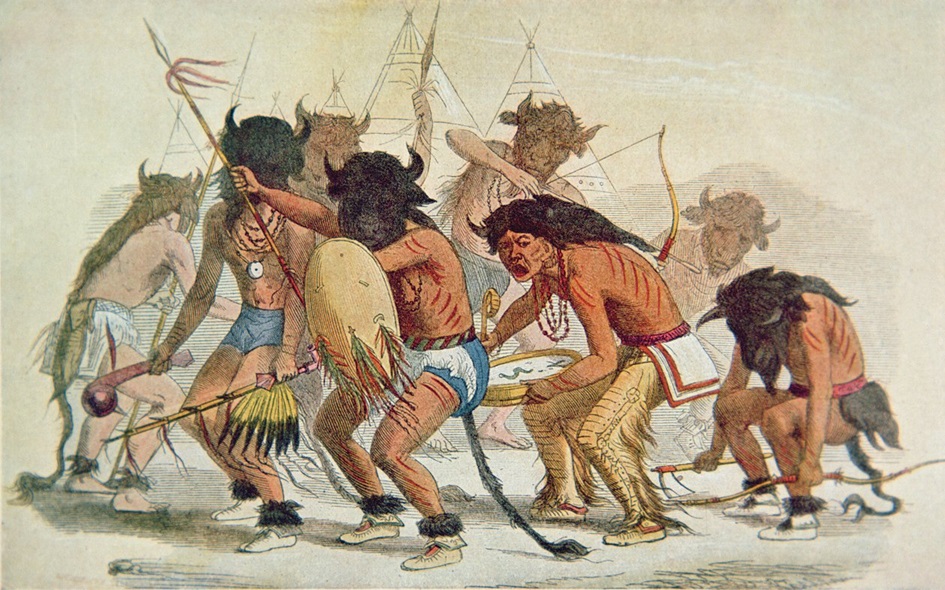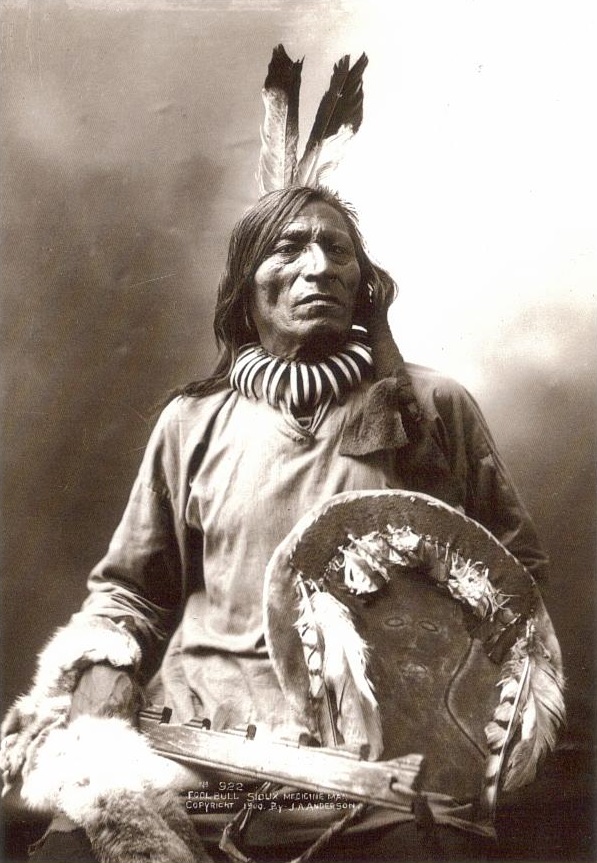|
|
|
|
This coloured print of an 1830s lithograph by George Catlin depicts a Sioux Buffalo Dance. Catlin was an American artist who visited the West five times during the 1830s, and devoted what he called "a lifetime of enthusiasm" to describing the scenes he saw in his letters and some 400 paintings. He has been accused of exaggerating his own importance, and of exploiting his Indigenous subjects for personal fame, but so many Indigenous people wanted to be painted by him that we must assume they were happy with his depictions..
|
Going DeeperThe following links will help you widen your knowledge: The website of St Joseph's Indian School, South Dakota, has wonderful information about Lakota Sioux beliefs and rites.
YouTube Listen to Elder Duane Hollow Horn Bear telling stories about the Lakota origins and the sacredness of water The Lakota virtue of Woohitika |
ReligionAlthough early settlers decided that they Indigenous Nations of the Plains had no religion, the opposite was true, and the Sioux were VERY religious: “Whenever the hunter came across a beautiful scene ... he paused for a moment in worship”. Although the Sioux believed in a Great Spirit – called Wakantanka – where wakan was the Power of the universe which gave life to all living things. The Sioux therefore believed that life was a shared possession and that they had kinship with all living things, including plants, animals ... and supernatural beings called wakampi ('spirits' who, if offended, might cause misfortune or death and needed appeasing). Thus spirituality permeated every aspect of their daily lives, and they continually performed small ceremonies and said prayers in honour of the spirits. When a young man ‘came of age’, he would take part in a ceremony which involved fasting, self-harm, going into a trance and seeing an animal that was a 'spirit friend'. This vision would be interpreted by the Wicasa wakan (‘holy man’) of the tribe. Pictures of visions were drawn on the tipis. After this, the young man would know his future and gain his adult name, e.g. Crazy Horse. Visions were also important in later life. Sitting Bull removed strips of skin from his body before the Battle of Little Bighorn and the vision that he had of men in blue uniforms falling was a reason why his warriors believed that they would win the battle (and they did). The Wicasa wakan was important because the Sioux believed that spirits caused the harsh, unpredictable weather of the Plains; he cured illnesses and talked to the spirits. The Sioux believed that they could get closer to the spirits by dancing; as well as dancing, this involved meditation, fasting or enduring pain. Dances happened before battles or raids and before and after a buffalo hunt. The most famous dance, common to many Indigenous Nations, was the Sun Dance for spiritual healing and the welfare of their communities: men fasted and meditated and warriors were then suspended from the roof supported by skewers through holes in their chests. The Buffalo Dance brought the buffalo; the Cheyenne performed an Animal Dance to bring luck to hunters; and the Caddo performed the Turkey Dance, which celebrated the return of warriors from battle.
ValuesIndigenous people “true lovers of Nature”. They connected their lives to Nature; they accepted they were part of nature and ought to live in such a way as to fit in with Nature. “Man’s heart away from Nature becomes hard”, said the Sioux Chief Luther Standing Bear. They loved the land, which they called their ‘mother’ – it had been put here by the Great Spirit to support mankind. The land was eternal and imperishable, beautiful and there to be enjoyed. It was also holy and to be venerated – Spirits lived in the earth whom it was unwise to anger, and the ancestors were buried there. Land could not be bought or sold; it belonged to all creatures (imagine someone trying to sell you the wind or the air) and could not be 'owned' by anyone – indeed it needed to be unfenced and unfarmed, because the buffalo needed open land to migrate. Circles were particularly important to the Plains Indians, who saw life as a circle (see Source B). They would put their camps in a circle to remain close to the spirits, their tipi was a circle and the migrating buffalo moved in circles. The hunt was dangerous so men often died young, and because there was a need to take care of the women and children, marriage was easy; at 17 a youth paid a dowry of horses and took his bride (aged 12-15). Since a good hunter would need more than one wife to prepare the many buffalo he killed, most tribes allowed polygamy. The basis of Sioux society was kinship with the members of their community/clan; to be good kin was to be human, to be civilised, and was the aim and constant ambition of each Sioux. The Akicita (warrior societies) who returned from the hunt saw it as their sacred duty to feed first the aged and the weak. In like manner, the very old, when they ceased to be of any use, would simply refuse to move with the tribe and be left behind to die (the practice of 'exposure').
|
Source A
A photo of 'Sioux
Medicine Man' Tatanka Witko ('Fool Bull')
in 1900. |
Source BHave you noticed that everything an Indian does is in a circle, and this is because the Power of the World always works in circles. The sky is round, and I am told that the earth is round like a ball. The wind, in its great power, whirls round. The seasons go round and round in a circle. The life of a man is a circle, from child to childlike. Our tipis were round like the nests of birds and were always set out in a circle. Black Elk, a Wicasa wakan of the Oglala Sioux
Source CAmongst a people so ignorant and superstitious, the success of their hunts and wars is often attributed to the strict observance of several propitiatory modes of singing and dancing to the Great (or other) Spirit; soliciting his countenance, and promising to give to him (which they always do), by sacrificing, the choicest piece of the animal slain in their hunts. The wild and deafening songs sung on these occasions are exceedingly curious, and called Medicine (Mystery) Songs. All tribes have their medicine songs peculiar for the hunting of each animal they choose to go in pursuit of, and by singing these songs they conciliate the supposed invisible deity or spirit presiding over these animals' respective destinies, and who must necessarily be consulted in this way. George Catlin, the description accompanying his illustration of a Mandan Buffalo Dance, in
Hunting Scenes and Amusements of the Rocky Mountains and Prairies of America (1845)
Source DMy attention was directed [to] a very aged and emaciated man of the tribe, who he told me was to be exposed … too old to travel, being reduced to mere skin and bones, [he] was to be left to starve, or meet with such death as might fall to his lot, and his bones to be picked by the wolves! “My children”, said he, “my strength is no more; my days are nearly all numbered, and I am a burthen to my children – I cannot go, and I wish to die”. This cruel custom of exposing their aged people, belongs, I think, to all the tribes who roam about the prairies. George Catlin, Letter #27, in Letters and Notes on the Manners, Customs and Conditions of North American Indians (1832)
|
Consider:Make a list of all the ways the Sioux way of life was influenced by their religion.
|
|
| |

